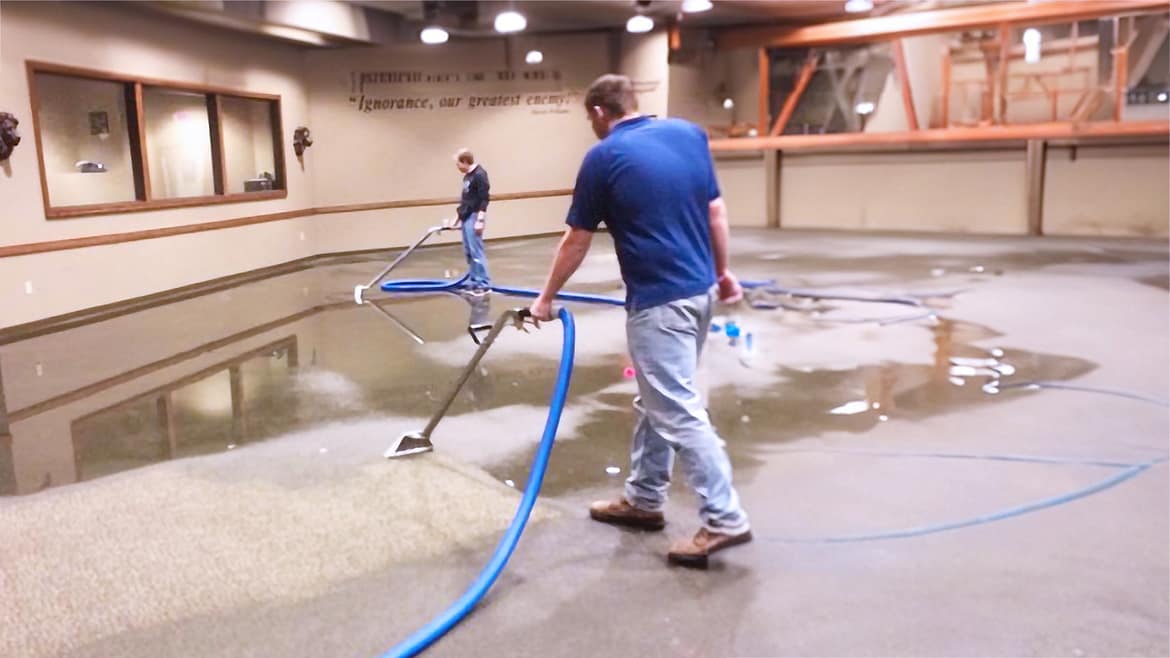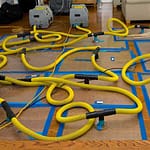Are you facing the daunting challenge of water damage in your home or office? Don’t worry, you’re not alone. From burst pipes to severe storms, water damage can strike unexpectedly and wreak havoc on your property. However, with the right knowledge and steps, you can effectively mitigate the damage and restore your space to its former glory.
In this ultimate guide, we will walk you through the 10 essential steps for water extraction in Phoenix, equipping you with the knowledge and tools necessary to tackle this arduous task with confidence. Imagine waking up to find your basement flooded or returning home after a vacation to discover a burst pipe has turned your living room into a shallow swimming pool. The initial shock and panic can be overwhelming, but it’s crucial to act swiftly to prevent further damage.
That’s where water extraction comes into play. It involves the process of removing excess water from your property, drying out the affected areas, and restoring the structural integrity of your space. While the task may seem daunting, our comprehensive guide will break it down into easy-to-follow steps, ensuring a smooth and efficient water extraction process. With each step, you will learn valuable insights and expert tips on how to assess the extent of the damage, prioritize actions, and navigate through potential obstacles.
We will also delve into the importance of safety measures, such as shutting off electrical sources and wearing protective gear, to ensure your well-being throughout the process. By following this ultimate guide, you’ll gain the knowledge and confidence to handle water extraction like a pro, saving time, money, and minimizing the long-term effects of water damage. So, let’s dive in and discover the 10 essential steps for water extraction in Phoenix!
Understanding the Importance of Water Extraction
Water extraction is a crucial step in dealing with water damage in Phoenix. Whether it’s due to a burst pipe, heavy rain, or flooding, removing water promptly is vital to prevent further damage. Water extraction involves the removal of excess water from affected areas to minimize the risk of mold growth, structural damage, and other long-term issues.
There are several essential steps involved in water extraction in Phoenix. Firstly, it’s important to assess the extent of the damage and identify the source of the water. Once this is done, professionals can use specialized equipment such as pumps, vacuums, and dehumidifiers to extract the water effectively. It’s crucial to act quickly to prevent any secondary damage and ensure a thorough extraction process.
Overall, understanding the importance of water extraction in Phoenix is key to mitigating the effects of water damage. By promptly removing excess water and drying out affected areas, homeowners can minimize the risk of further issues and restore their property to its pre-damaged state.

Step 1: Assessing the Damage
Step 1: Assessing the Damage
Before starting the water removal process in Phoenix, it is crucial to assess the extent of the water damage. Aqua Dry Water Damage Restoration, a leading water extraction company in Phoenix, emphasizes the importance of this initial step. By thoroughly evaluating the situation, professionals can determine the best course of action to minimize further damage.
During the assessment, water damage restoration experts in Phoenix utilize advanced equipment and techniques to identify affected areas. This includes using moisture meters to detect hidden moisture and thermal cameras to locate water pockets behind walls or under floors. By understanding the full scope of the damage, technicians can create a tailored plan for efficient water extraction.
The assessment stage also allows experts to identify potential safety hazards, such as electrical issues or structural damage, ensuring a safe working environment. Additionally, by documenting the damage, homeowners can provide accurate information to their insurance companies for a smoother claims process.
In conclusion, properly assessing the water damage is the crucial first step in any water removal process. Aqua Dry Water Damage Restoration’s experienced team in Phoenix understands the importance of this step, ensuring a thorough evaluation of the damage to provide effective and efficient restoration services.
Step 2: Ensuring Safety First
Ensuring safety is the first and foremost step when it comes to flood cleanup in Phoenix. The process can be complex and hazardous, so following the necessary precautions is crucial. Start by assessing the area for any potential risks such as electrical hazards or structural damage. Before starting the extraction, make sure to wear protective gear such as gloves, goggles, and masks to prevent any health risks. Additionally, it is important to turn off all power sources in the affected area to avoid any electrical accidents. Taking these essential safety measures will ensure a smooth and secure water extraction process in Phoenix.
Step 3: Shutting off Electrical Sources
Step 1: Identify All Electrical Sources
Before starting any water restoration process in Phoenix, it is crucial to ensure your safety by shutting off all electrical sources in the affected area. This step is necessary to prevent any potential electrocution or damage to electrical equipment. Remember to turn off the main power supply from the circuit breaker or fuse box.
Step 2: Unplug Appliances and Electronics
Once the main power is switched off, unplug all appliances and electronics in the water-damaged area. This will prevent any short circuits or damage to your devices. Be cautious while handling wet electrical cords and avoid touching them with wet hands.
By following these initial steps of shutting off electrical sources and unplugging appliances, you can minimize the risk of electrical hazards during the water extraction process in Phoenix. Prioritizing safety is essential to ensure a smooth and secure restoration process.
Step 4: Removing Standing Water
When it comes to flood cleanup in Phoenix, removing standing water is a crucial first step. Whether caused by a flood or a burst pipe, standing water can cause extensive damage if not promptly addressed. Start by shutting off the water source and ensuring the area is safe to enter. Then, use pumps, wet vacuums, or buckets to remove as much water as possible. Be sure to wear protective gear and use caution to avoid electrical hazards. Once the standing water is removed, you can proceed with the rest of the water removal and flood cleanup process.
Step 5: Extracting Water from Carpets and Furniture
Step 1: Assess the Damage
It is important to assess the extent of the damage caused by water in your carpets and furniture. Look for any visible signs of water damage, such as discoloration, warping, or mold growth. This will help you determine the best course of action for extracting the water effectively.
Step 2: Remove Excess Water
Start by removing any excess water from the affected areas. Use a wet vacuum or a mop to soak up as much water as possible. Be thorough and make sure to reach all the corners and crevices. This will prevent further damage and help speed up the drying process.
Remember to always prioritize safety and use protective gear such as gloves and boots when dealing with water damage. Additionally, consider contacting a professional water removal service in Phoenix to ensure a thorough and efficient extraction process.
Step 6: Drying Out the Affected Areas
Drying out the affected areas is a crucial step in the water extraction process in Phoenix. After removing the standing water, it is essential to thoroughly dry the affected areas to prevent further damage and the growth of mold and mildew.
To start the drying process, ensure proper ventilation by opening windows and using fans or dehumidifiers. This will help in circulating the air and expediting the drying process. Next, remove any wet materials such as carpets, furniture, and insulation to facilitate faster drying.
Focus on drying the walls by using air movers and directing them towards the affected areas. Additionally, use specialized equipment like moisture meters to monitor the moisture levels and ensure complete drying.
By following these steps, you can effectively dry out the affected areas, preventing any potential damage and promoting a safe and healthy environment.
Step 7: Preventing Mold and Mildew Growth
Preventing mold and mildew growth is crucial to maintaining a healthy indoor environment. One of the first steps in mold remediation is to address any water damage or leaks promptly. This is essential to prevent further moisture buildup and potential mold and mildew growth. By following these steps, you can effectively prevent their development.
Firstly, identify and fix any sources of water leaks or damage. This could include leaking pipes, roof leaks, or faulty plumbing. Next, ensure proper ventilation in areas prone to moisture, such as bathrooms and kitchens. Installing exhaust fans or opening windows can help remove excess moisture from the air. Additionally, using dehumidifiers can help reduce humidity levels in the room. Regularly clean and dry areas prone to moisture, such as shower curtains, bathroom tiles, and basement walls. Lastly, regularly inspect and maintain your HVAC system to prevent moisture buildup and ensure proper airflow. By following these steps, you can effectively prevent mold and mildew growth and maintain a healthy living environment.
Step 8: Evaluating Structural Damage
Step 1: Begin by assessing the extent of the structural damage caused by water.
Look for visible signs such as cracks in the walls or ceiling, warped floors, or sagging beams. Determine if the damage is localized or if it has spread throughout the entire structure.
Step 2: Next, identify the source of the water damage.
Was it caused by a burst pipe, a leaking roof, or a natural disaster? Understanding the cause will help in developing an effective plan for repair and restoration.
Step 3: Evaluate the integrity of the foundation.
Water damage can weaken the foundation, leading to structural instability. Look for signs of foundation cracks or shifting. Consider consulting a professional if you suspect significant damage.
Step 4: Inspect the walls and ceilings for signs of moisture.
Water stains, peeling paint, or mold growth indicate ongoing water damage and may require immediate attention.
Step 5: Check the electrical system for any water exposure.
Water and electricity can be a dangerous combination, so it’s crucial to ensure the safety of the premises before proceeding with repairs.
Step 6: Assess the condition of the plumbing system.
Look for leaks, blockages, or damaged pipes that may have caused the water damage. Repair or replace any faulty components to prevent further issues.
Step 7: Examine the flooring for signs of water damage.
Warped or buckled floorboards, discolored tiles, or damp carpets may indicate water infiltration. Determine the extent of the damage and plan repairs accordingly.
Step 8: Evaluate the structural integrity of windows and doors.
Look for signs of water damage around frames and check for proper sealing. Repair or replace any compromised components to prevent future water intrusion.
Step 9: Consider the overall safety of the structure.
Identify any hazards that may have resulted from the water damage and take necessary precautions to ensure a secure environment.
Step 10: Document the extent of the structural damage with photographs and detailed notes.
This information will be valuable for insurance claims and future reference during the restoration process.
Step 9: Restoring Your Property
When it comes to restoring your property after water damage, it is important to follow a step-by-step process. The first step in water extraction in Phoenix is to assess the damage and stop the source of the water. This could involve shutting off the main water supply or fixing a leaky pipe.
Once the source is under control, the next step is to remove any standing water using specialized equipment such as pumps or wet vacuums. It is crucial to act quickly to prevent further damage and the growth of mold and mildew. After the water has been extracted, the affected areas need to be thoroughly dried and dehumidified. This may involve using fans, dehumidifiers, or even opening windows to promote air circulation. It’s important to ensure that all moisture is eliminated to prevent future issues.
Once the property is dry, the next step is to clean and sanitize the affected areas. This may involve using disinfectants and specialized cleaning products to remove any bacteria or contaminants. Finally, it is important to address any repairs or renovations that may be necessary to restore the property to its pre-damage condition. This could include replacing damaged drywall, flooring, or plumbing fixtures.
Restoring your property after water damage can be a complex process, but by following these essential steps, you can ensure a successful restoration.
Step 10: Successfully Navigating the Water Extraction Process in Phoenix
Successfully navigating the water extraction process in Phoenix requires a systematic approach to address the issue effectively and have an understanding of what’s covered in your homeowners insurance. First, assess the extent of water damage and identify the source to prevent further damage.
Next, gather the necessary equipment and protective gear before starting the extraction process. Begin by removing any standing water using pumps or wet vacuums, and then extract moisture from carpets, furniture, and other affected areas using fans and dehumidifiers.
Don’t forget to thoroughly clean and disinfect surfaces to prevent mold growth. Ensure proper ventilation and monitor the drying progress regularly. Lastly, document the damage and contact your insurance company to initiate the claims process.
By following these essential steps, you can successfully navigate the water extraction process in Phoenix and restore your property efficiently.
FAQs
Q: What is water extraction?
A: Water extraction is the process of removing excess water from a location, such as a home or business, after a water-related incident, such as a flood or burst pipe. This process is crucial to prevent further damage and restore the affected area to its pre-incident condition.
Q: Why is water extraction important?
A: Water extraction is important because standing water can quickly lead to structural damage, mold growth, and other health hazards. By promptly removing the water, you can minimize these risks and prevent long-term issues.
Q: How long does the water extraction process take?
A: The duration of the water extraction process depends on various factors, including the extent of the water damage and the size of the affected area. It can range from a few hours to several days.
Q: Can I perform water extraction myself?
A: While minor incidents may be manageable on your own, it is generally recommended to hire professionals for water extraction. They have the necessary equipment, expertise, and experience to ensure thorough and efficient extraction.
Q: How much does water extraction cost?
A: The cost of water extraction can vary depending on the severity of the damage, the size of the affected area, and other factors. It is best to consult with a professional water extraction company for an accurate assessment and cost estimate.
Q: Will my insurance cover water extraction?
A: Many insurance policies provide coverage for water damage and water extraction, but it is essential to review your policy and contact your insurance provider to understand the specifics of your coverage.
Q: What should I do before professionals arrive for water extraction?
A: Before professionals arrive, try to turn off the water source, remove any valuable items from the affected area, and ensure your safety by avoiding contact with electrical outlets or standing water.
Q: How can I prevent water damage in the future?
A: To prevent water damage in the future, regularly inspect and maintain your plumbing system, address leaks and drips promptly, install a sump pump if necessary, and ensure proper drainage around your property.
Q: Can water extraction remove all the damage caused by water?
A: While water extraction is crucial for removing excess water, it may not eliminate all the damage caused by water. Additional restoration and repairs may be necessary to fully restore the affected area.
Q: Who should I contact for professional water extraction services in Phoenix?
A: For professional water extraction services in Phoenix, it is recommended to contact a reputable water damage restoration company that specializes in water extraction and restoration services.




